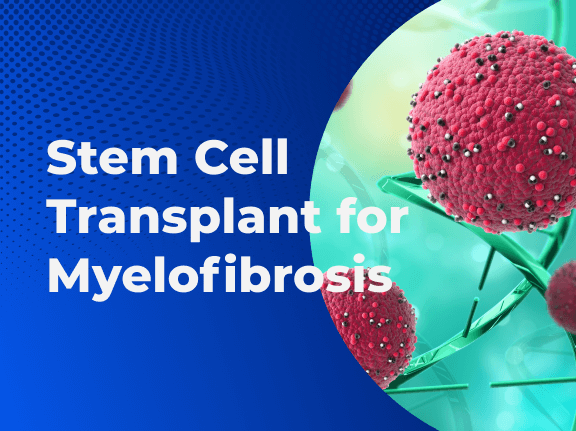Stem Cell Transplant for Myelofibrosis
Stem cell transplant for myelofibrosis remains the only curative treatment available to patients today. Myelofibrosis is a rare type of blood cancer that affects the bone marrow, the spongy tissue within bones that creates blood cells. Myelofibrosis leads to bone marrow fibrosis, where the bone marrow is scarred, and blood cell production will be affected. Myelofibrosis is an indolent cancer, so it develops slowly over several years. In myelofibrosis, the prognosis is favorable for most patients and symptoms can be managed with palliative care. In more serious cases, doctors will consider an allogenic stem cell transplantation (ASCT). ASCT is the most intensive treatment option for myelofibrosis, so not all patients are eligible for the procedure. Eligibility depends on the patient’s age, overall health, symptoms present, and more.
Myelofibrosis belongs to a larger group of blood cancers called myeloproliferative neoplasms (MPNs) where the bone marrow produces abnormal blood cells. Other MPNs include:
- Chronic eosinophilic leukemia
- Polycythemia vera
- Chronic myelogenous leukemia
- Essential thrombocythemia
- Chronic neutrophilic leukemia
When myelofibrosis develops on its own and not from other blood or bone marrow diseases, it is referred to as primary myelofibrosis (PMF). When another MPN such as polycythemia vera or essential thrombocythemia causes myelofibrosis to develop, it is referred to as secondary myelofibrosis (SMF). Only an estimated 10 to 20 percent of all myelofibrosis cases are SMF.
What Is the Stem Cell?
Stem cells are cells inside the bone marrow that are immature. Overtime they mature into platelets, red blood cells, or white blood cells. Platelets help aid in blood clotting, white blood cells fight infection, and red blood cells carry nutrients and oxygen to organs and tissues throughout the body.
In patients with myelofibrosis, mutations in the stem cells’ DNA leads to the growth and replication of abnormal blood cells. As there are less and less healthy blood cells remaining, the bone marrow hardens and is scarred.
Finding a Stem Cell Donor
The first option for most patients seeking donors for any kind of blood cells are siblings and other family members. Potential donors will need to get their blood tested to ensure they are a match for the patient’s blood. For patients without family members who can be donors, you can register for a national donor registry, which can take a few weeks or up to several months. Once the donor is found, stem cells are collected through a procedure called peripheral stem cell harvest.
How Is the Transplant Done?
Once the donor is selected, doctors will try to kill as many cancer cells as possible through chemotherapy and/or radiation therapy. This also helps weaken the immune system, so the stem cells won’t be attacked once in the body. After the selected treatment is finished, the doctor will then use a long thin tube to inject the new stem cells through a vein in the neck or chest. The procedure only takes an hour, but the recovery can take up to a few weeks up to a month in the hospital.
Once the stem cells are injected and patient has recovered, the healthy stem cells will begin to attack and kill cancerous cells in the body.
There are other methods of stem cell transplants being studied that are less invasive than an ASCT. The nonmyeloablative (mini) transplant requires less chemotherapy and radiation therapy prior to the procedure, reducing the risk of infection after the procedure.
Do Stem Cell Transplants Cure Myelofibrosis?
ASCT remains the only curative treatment for myelofibrosis. For older patients and those who are not eligible for an ASCT, other new and alternative myelofibrosis treatments such as targeted therapies and immunotherapies are available to cancer patients of all stages and subtypes in clinical trials. ACST are generally recommended to patients who are either young, or older patients who are in shape with no other serious pre-existing health conditions.
What Is the Success Rate of Stem Cell Transplants for Myelofibrosis?
In some cases of ASCT, there are adverse events that occur within two years after the procedure. In a study of 2,459 PMF and SMF patients between 1995 and 2014 who received ASCT, 1,055 patients were alive and disease-free after two years. For the entire study, the 10-year survival rate was 41 percent, and a disease-free rate of 32 percent. Of the 1,055 patients who were disease-free after two years, 166 reportedly died within 10 years of the ASCT. The most common complication for this group of patients was a relapse of myelofibrosis, followed by susceptibility to infection. This should be considered prior to moving forward with an ASCT and patients should talk with their doctor about what is best for their individual case.
Overall, the 10-year survival rate of those who survived two years post ASCT is 74 percent. Therefore, patients who don’t relapse with myelofibrosis or get multiple infections, are likely to live long-term after the procedure. Most complications occur within two years of the procedure.
To learn more about Myelofibrosis, read our ultimate guide: Myelofibrosis Ultimate Guide
Follow Up Care After Stem Cell Transplant
After the ASCT, the risk of infection is greatly increased, and bleeding is caused more easily due to the suppressed immune system. Patients stay in an isolated room in the hospital while being monitored by doctors and specialists. Antibiotics will be administered via IV to lower the risk of infection. Medications may also be given to patients to prevent graft-versus-host-disease.
Patients often can return home once their blood levels are normal after the new stem cells produce new blood cells. Frequent visits to the doctor are necessary after returning home to ensure the blood cell levels continue to be normal. Full recovery can take up to a few months for ASCT in myelofibrosis.
Sources:













4 Comments
Have you started any trials regarding Myelofibrosis?
There are multiple clinical trials around the world to assist those individuals with myelofibrosis. We can help with connecting you to the clinical trials that best match your diagnosis.
I am 49 and vas diagnosed wit myelofibrosis. Please I would like to know about new trial and as much information as possible.
Thanks for your message, we are sorry to hear about your diagnosis. We would be happy to help. You can learn more about available cancer treatment options and clinical trials here: https://hubs.ly/Q01yygDr0.
You can also contact one of our Patient Relations Coordinators via phone or email at 844-627-7246 & support@massivebio.com.